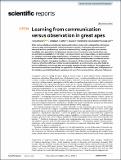Files in this item
Learning from communication versus observation in great apes
Item metadata
| dc.contributor.author | Marno, Hanna | |
| dc.contributor.author | Voelter, Christoph J. | |
| dc.contributor.author | Tinklenberg, Brandon | |
| dc.contributor.author | Sperber, Dan | |
| dc.contributor.author | Call, Josep | |
| dc.date.accessioned | 2022-02-21T12:30:09Z | |
| dc.date.available | 2022-02-21T12:30:09Z | |
| dc.date.issued | 2022-02-21 | |
| dc.identifier | 277708447 | |
| dc.identifier | d8f47b00-0049-4efe-bddf-3973bc90e7a6 | |
| dc.identifier | 85125155637 | |
| dc.identifier | 000759084600031 | |
| dc.identifier.citation | Marno , H , Voelter , C J , Tinklenberg , B , Sperber , D & Call , J 2022 , ' Learning from communication versus observation in great apes ' , Scientific Reports , vol. 12 , 2917 . https://doi.org/10.1038/s41598-022-07053-2 | en |
| dc.identifier.issn | 2045-2322 | |
| dc.identifier.other | ORCID: /0000-0002-8597-8336/work/108917602 | |
| dc.identifier.uri | https://hdl.handle.net/10023/24914 | |
| dc.description | This research was supported by the European Research Council (ERC) under the European Union’s Seventh Framework Programme (FP7/2007-2013)/ERC Grant 609819 (SOMICS project). | en |
| dc.description.abstract | When human infants are intentionally addressed by others, they tend to interpret the information communicated as being relevant to them and worth acquiring. For humans, this attribution of relevance leads to a preference to learn from communication, making it possible to accumulate knowledge over generations. Great apes are sensitive to communicative cues, but do these cues also activate an expectation of relevance? In an observational learning paradigm, we demonstrated to a sample of nonhuman great apes (bonobos, chimpanzees, orangutans; N = 24) how to operate on a food dispenser device. When apes had the opportunity to choose between an effective and an ineffective method in the baseline conditions, the majority of them chose the effective method. However, when the ineffective method was demonstrated in a communicative way, they failed to prioritize efficiency, even though they were equally attentive in both conditions. This suggests that the ostensive demonstration elicited an expectation of relevance that modified apes’ interpretation of the situation, potentially leading to a preference to learn from communication, as human children do. | |
| dc.format.extent | 9 | |
| dc.format.extent | 1639131 | |
| dc.language.iso | eng | |
| dc.relation.ispartof | Scientific Reports | en |
| dc.subject | BF Psychology | en |
| dc.subject | QL Zoology | en |
| dc.subject | DAS | en |
| dc.subject | MCC | en |
| dc.subject.lcc | BF | en |
| dc.subject.lcc | QL | en |
| dc.title | Learning from communication versus observation in great apes | en |
| dc.type | Journal article | en |
| dc.contributor.sponsor | European Research Council | en |
| dc.contributor.institution | University of St Andrews. School of Psychology and Neuroscience | en |
| dc.contributor.institution | University of St Andrews. Centre for Social Learning & Cognitive Evolution | en |
| dc.identifier.doi | 10.1038/s41598-022-07053-2 | |
| dc.description.status | Peer reviewed | en |
| dc.identifier.grantnumber | 609819 | en |
This item appears in the following Collection(s)
Items in the St Andrews Research Repository are protected by copyright, with all rights reserved, unless otherwise indicated.

